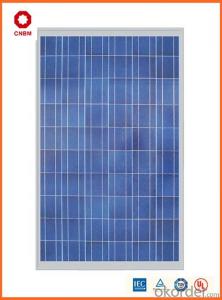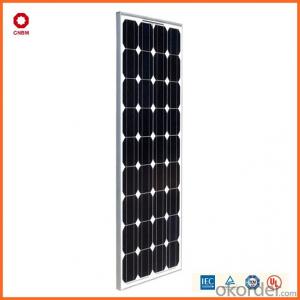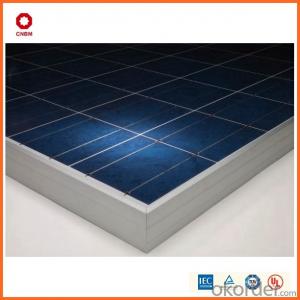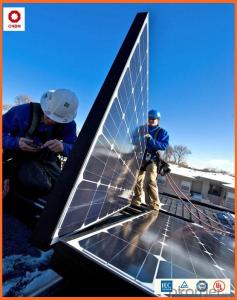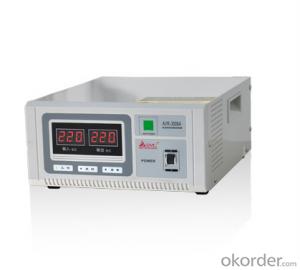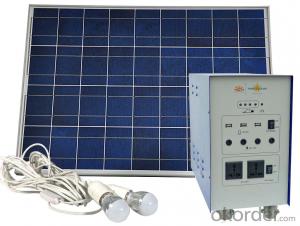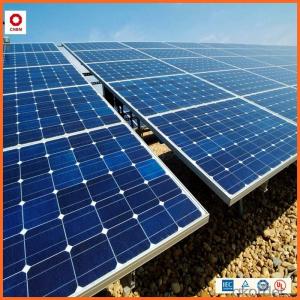135w Small Solar Panels in Stock China Manufacturer
- Loading Port:
- China main port
- Payment Terms:
- TT OR LC
- Min Order Qty:
- 1 watt
- Supply Capability:
- 10000000 watt/month
OKorder Service Pledge
OKorder Financial Service
You Might Also Like
Item specifice
Product Description:
Hot Sale !!! Quality and Safety of Small Poly Solar Panel 5w~150w
1. Rigorous quality control meets the highest international standards.
2. High-transmissivity low-iron tempered glass, strong aluminium frame.
3. Using UV-resistant silicon.
4. IS09001/14001/CE/TUV/UL
Warranties of Small Poly Solar Panel 35~85w
1. 10 years limited product warranty
2. 15 years at 90% of the minimal rated power output
3. 25 years at 80% of the minimal rated power output
Specification
Characteristics of Poly solar panels CNBM (245-320W) | |||||
Max Power Voltage Vmp(V) | 30.3 | 30.8 | 31.1 | 31.4 | 31.85 |
Max Power Current Imp(A) | 7.60 | 7.64 | 7.73 | 7.81 | 7.85 |
Open Circuit Voltage Voc(V) | 36.1 | 36.6 | 37 | 37.3 | 37.68 |
Short Circuit Current Isc(A) | 8.50 | 8.55 | 8.65 | 8.75 | 8.85 |
Max Power Pm(W) | 230W | 235W | 240W | 245W | 250W |
Temperature Coefficient of Cells Poly solar panels CNBM (245-320W) | |
NOCT | 45± 2 |
Temperature Coeffucients of Isc | 0.0492 |
Temperature Coeffucients of Voc | -0.3374 |
Temperature Coeffucients of Voc | -0.4677 |
Mechanical Data of Poly solar panels CNBM (245-320W) | |
Dimension | 1638 × 982 × 40 mm |
Weight | 19.5 kg |
No. of Cells and Connections | 60 (6 ×10) |
Tolerance | 0 ~ + 5 W |
Cell | Monocrystalline Cell 156 × 156 mm |
Packing | 624 Pcs/40ft(H) Container |
Limits of Poly solar panels CNBM (245-320W) | |
Operating Temperature | -40 to +85 |
Storage Temperature | -40 to +85 |
Max System Voltage | 1000VDC(IEC) / 600VDC(UL) |
Features of our products:
• High conversion efficiency mono/poly-crystalline amorphous silicon solar cells
• Modules incorporate high performance bypass diodes to minimize the power drop caused by shading
• High transmittance, low-iron tempered glass
• High performance EVA encapsulant to prevent destroying and water.
• AI frame: without screw, corner connection. 8 holes on the frame can be installed easily
• Good performance of preventing from atrocious weather such as wind and hails
• Certifications: CE IEC TUV VDE UL, Class I
• 10 years 90% power output warranty

Shipping of Small Poly Solar Panel 35~85w
By Sea | Delivery from Shanghai or Ningbo seaport |
By Air | Departure from Shanghai Pudong Airport |
By Express | Post by DHL, EMS, UPS, TNT. |
Features of our products:
• High conversion efficiency mono/poly-crystalline amorphous silicon solar cells
• Modules incorporate high performance bypass diodes to minimize the power drop caused by shading
• High transmittance, low-iron tempered glass
• High performance EVA encapsulant to prevent destroying and water.
• AI frame: without screw, corner connection. 8 holes on the frame can be installed easily
• Good performance of preventing from atrocious weather such as wind and hails
• Certifications: CE IEC TUV VDE UL, Class I
• 10 years 90% power output warranty
As a professional Solar Panel manufacturer and Supplier in China, we have our customers come around the whole world and our specialization has got a worldwide recognition. Meanwhile, with our superior quality, competitive price, prompt and excellent service, As main role in trade section of CNBM Group, CNBM International Corporation supplies products including Monocrystalline Solar Panel, Polycrystalline Solar Panel ( multicrystalline silicon Solar Panel) have received and enjoyed famous reputation in many countries and regions in the world.
- Q:Can solar energy systems be used in powering outdoor signage or billboards?
- Indeed, outdoor signage or billboards can be powered by solar energy systems. By placing solar panels on the roof or nearby structures, sunlight can be captured and transformed into electricity. This generated electricity is then employed to illuminate the lights or operate the digital displays of the signage or billboards, enabling them to function autonomously without relying on the conventional power grid. Given their prevalence in sun-drenched areas, solar energy systems are especially well-suited for outdoor signage. Moreover, utilizing solar energy aids in mitigating the carbon footprint linked to traditional methods of electricity production, rendering it an eco-friendly alternative.
- Q:What is the installation process for a solar energy system?
- The installation process for a solar energy system typically involves several steps. Firstly, a site visit is conducted to assess the roof or ground space for solar panel placement and to determine the solar potential of the location. Then, the necessary permits and paperwork are obtained from the local authorities. Next, the solar panels and related equipment are installed, which includes mounting the panels, connecting the electrical components, and setting up the inverter to convert the DC electricity generated by the panels into usable AC electricity. Finally, the system is inspected and connected to the grid or battery storage, and the homeowner or business owner is educated about the system's operation and maintenance.
- Q:How do solar energy systems impact energy storage technologies?
- Solar energy systems have a significant impact on energy storage technologies by providing a clean and renewable source of electricity. These systems generate electricity during the day when the sun is shining, but often produce more energy than needed. Energy storage technologies allow excess energy to be stored and used during periods of low or no solar generation, ensuring a constant and reliable power supply. This integration of solar energy systems with energy storage technologies promotes grid stability, reduces reliance on fossil fuels, and accelerates the transition towards a sustainable energy future.
- Q:Can solar energy systems be used in powering concert halls or auditoriums?
- Yes, solar energy systems can be used to power concert halls or auditoriums. These systems can be installed on the rooftop or nearby areas to harness sunlight and generate electricity. The generated solar power can then be used to run the lighting, sound systems, and other electrical equipment required for concerts or performances. Additionally, solar energy systems can be integrated with battery storage solutions to ensure a continuous power supply, even during periods of low sunlight or at night.
- Q:Are there any limitations to using solar energy for powering vehicles?
- Yes, there are some limitations to using solar energy for powering vehicles. The main limitation is the limited amount of energy that can be harvested from the sun, especially when compared to the energy density of conventional fossil fuels. Additionally, solar panels require a large surface area for installation, which could be a challenge for vehicles with limited space. Moreover, solar energy is intermittent, meaning it is not available during the night or in cloudy weather, which might affect the reliability and range of solar-powered vehicles. Finally, the cost of solar panels and their relatively low efficiency in converting sunlight to electricity also pose challenges to widespread adoption. Nonetheless, advancements in technology and the development of energy storage solutions are helping to overcome some of these limitations and make solar-powered vehicles more viable.
- Q:Can solar energy systems be used for powering data centers or server farms?
- Yes, solar energy systems can be used to power data centers or server farms. By harnessing the power of the sun through photovoltaic panels, solar energy can provide a sustainable and renewable source of power for these energy-intensive facilities. This can help reduce their carbon footprint and reliance on traditional grid electricity, making them more environmentally friendly and cost-effective in the long run. However, implementing solar energy systems for large-scale data centers or server farms may require careful planning, adequate space, and backup storage solutions to ensure consistent power availability.
- Q:Are there any limitations to the use of solar energy systems?
- Yes, there are limitations to the use of solar energy systems. Some common limitations include the intermittent nature of sunlight, which means solar power generation may be affected by weather conditions and variations in daylight hours. Additionally, the initial installation cost of solar systems can be expensive, although it is often offset by long-term savings. The efficiency of solar panels can also be affected by factors such as shading and dust accumulation. Finally, the storage and distribution of solar energy can be challenging, as it requires the use of batteries or connection to the grid.
- Q:How do solar energy systems affect energy bills?
- Solar energy systems can have a significant impact on energy bills by reducing or even eliminating the need to purchase electricity from the grid. These systems generate electricity from sunlight, which can be used to power homes or businesses. When excess electricity is produced, it can be fed back into the grid, earning credits or reducing the overall bill. As a result, solar energy systems can greatly reduce energy bills over time, providing long-term cost savings and potentially even making households or businesses energy independent.
- Q:Can solar energy systems be used for powering transportation infrastructure?
- Yes, solar energy systems can be used for powering transportation infrastructure. Solar panels can be installed on vehicles, such as electric cars, buses, and even boats, to generate electricity for their operation. Additionally, solar-powered charging stations can be set up along highways and roads to provide renewable energy for electric vehicles. These systems help reduce dependence on fossil fuels and contribute to a more sustainable and environmentally friendly transportation system.
- Q:Can solar energy systems be used for powering disaster relief efforts?
- Yes, solar energy systems can be used for powering disaster relief efforts. Solar panels can provide a reliable and sustainable source of electricity, especially in areas where the traditional power grid may be disrupted or inaccessible. These systems can power emergency communication devices, medical equipment, lighting, and other essential needs during disaster situations, offering a clean and renewable energy solution.
1. Manufacturer Overview |
|
|---|---|
| Location | |
| Year Established | |
| Annual Output Value | |
| Main Markets | |
| Company Certifications | |
2. Manufacturer Certificates |
|
|---|---|
| a) Certification Name | |
| Range | |
| Reference | |
| Validity Period | |
3. Manufacturer Capability |
|
|---|---|
| a)Trade Capacity | |
| Nearest Port | |
| Export Percentage | |
| No.of Employees in Trade Department | |
| Language Spoken: | |
| b)Factory Information | |
| Factory Size: | |
| No. of Production Lines | |
| Contract Manufacturing | |
| Product Price Range | |
Send your message to us
135w Small Solar Panels in Stock China Manufacturer
- Loading Port:
- China main port
- Payment Terms:
- TT OR LC
- Min Order Qty:
- 1 watt
- Supply Capability:
- 10000000 watt/month
OKorder Service Pledge
OKorder Financial Service
Similar products
New products
Hot products
Hot Searches
Related keywords
